
- •Contents
- •Preface
- •1 Introduction: the significance of radiobiology and radiotherapy for cancer treatment
- •2 Irradiation-induced damage and the DNA damage response
- •3 Cell death after irradiation: how, when and why cells die
- •4 Quantifying cell kill and cell survival
- •5 Dose–response relationships in radiotherapy
- •6 Linear energy transfer and relative biological effectiveness
- •7 Tumour growth and response to radiation
- •8 Fractionation: the linear-quadratic approach
- •9 The linear-quadratic approach in clinical practice
- •10 Modified fractionation
- •11 Time factors in normal-tissue responses to irradiation
- •12 The dose-rate effect
- •13 Pathogenesis of normal-tissue side-effects
- •14 The volume effect in radiotherapy
- •15 The oxygen effect and fractionated radiotherapy
- •16 The tumour microenvironment and cellular hypoxia responses
- •17 Therapeutic approaches to tumour hypoxia
- •18 Combined radiotherapy and chemotherapy
- •19 Retreatment tolerance of normal tissues
- •20 Molecular image-guided radiotherapy with positron emission tomography
- •21 Molecular-targeted agents for enhancing tumour response
- •22 Biological response modifiers: normal tissues
- •23 Molecular targeting and patient individualization
- •24 Protons and other ions in radiotherapy
- •25 Second cancers after radiotherapy
- •Glossary of terms in radiation biology
- •Index

8
Fractionation: the linear-quadratic approach
MICHAEL C. JOINER AND SØREN M. BENTZEN
8.1 |
Introduction |
102 |
8.10 |
Alternative isoeffect formulae based |
|
8.2 |
Historical background: LQ versus |
|
|
on the LQ model |
114 |
|
power-law models |
103 |
8.11 |
Limits of applicability of the simple |
|
8.3 |
Cell-survival basis of the LQ model |
104 |
|
LQ model, alternative models |
116 |
8.4 |
The LQ model in detail |
105 |
8.12 |
Beyond the target cell hypothesis |
116 |
8.5 |
The value of α/β |
106 |
Key points |
117 |
|
8.6 |
Hypofractionation and hyperfractionation |
108 |
Bibliography |
117 |
|
8.7 |
Equivalent dose in 2-Gy fractions (EQD2) |
109 |
Further reading |
118 |
|
8.8 |
Incomplete repair |
109 |
Appendix: summary of formulae |
118 |
|
8.9 |
Should a time factor be included? |
112 |
|
|
|
|
|
|
|
|
|
8.1 INTRODUCTION
Major developments in radiotherapy fractionation have taken place during the past three decades and these have grown out of understanding in radiation biology. The relationships between total dose and dose per fraction for lateresponding tissues, acutely responding tissues and tumours provide the basic information required to optimize radiotherapy according to the dose per fraction and number of fractions.
A milestone in this subject was the publication by Thames et al. (1982) of a survey of isoeffect curves for various normal tissues, mainly in mice. Their summary is shown in Fig. 8.1. Each of the investigations contributing to this chart was a study of the response of a normal tissue to fractionated radiation treatment using a range of doses per fraction. In order to minimize the effects of repopulation, the survey was restricted to studies in which the overall time was kept short by the
use of multiple treatments per day, or ‘where an effect of regeneration of target cells was shown to be unlikely’. This summary thus represents the influence of dose per fraction on response and mostly excludes the influence of overall treatment time. It was possible in each study, and for each chosen dose per fraction, to determine the total radiation dose that produced some defined level of damage to the normal tissue. These endpoints of tolerance differed from one normal tissue or experimental study to another. Each line in Fig. 8.1 is an isoeffect curve determined in this way. The dashed lines show isoeffect curves for acutely responding tissues and the full lines are for lateresponding tissues. Note that fraction number increases from left to right along the abscissa and therefore the dose per fraction scale decreases from left to right. The results of this survey show that the isoeffective total dose increases more rapidly with decreasing dose per fraction for late effects than for acute effects. If the vertical axis is
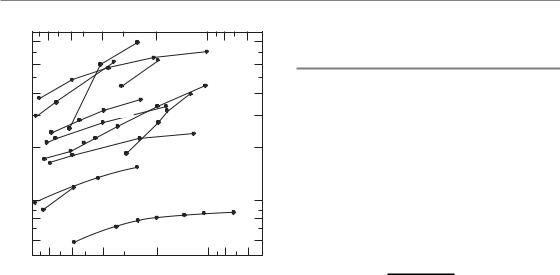
Historical background 103
|
80 |
|
|
|
Skin (acute) |
|
|
|
|
|
|
Skin (late) |
|
|
|||
isoeffects |
60 |
|
|
|
|
|
||
|
|
|
|
|
|
|
||
50 |
|
|
|
Skin (late) |
|
|
||
40 |
|
Spinal |
Colon |
|
|
|
|
|
various |
30 |
|
cord |
Testis |
|
Kidney |
|
|
|
|
|
|
|
||||
|
|
|
Lung |
|
|
|
|
|
20 |
|
|
|
|
Jejunum |
|
|
|
– |
|
|
|
|
|
|
||
|
|
|
|
|
|
|
||
(Gy) |
|
|
|
|
|
|
|
|
|
|
|
|
|
|
|
|
|
dose |
|
|
|
Fibrosarcoma |
|
|
||
10 |
|
Vertebra growth |
|
|
|
|
||
Total |
|
|
|
|
|
|||
8 |
|
|
|
|
Bone marrow |
|
||
|
|
|
|
|
|
|
||
|
6 |
|
|
|
|
|
|
|
|
10 |
8 |
6 |
4 |
2 |
1 |
0.8 |
0.6 |
Dose/fraction (Gy)
Figure 8.1 Relationship between total dose and dose per fraction for a variety of normal tissues in experimental animals. The results for late-responding tissues (unbroken lines) are systematically steeper than those for early-responding tissues (broken lines). From Thames et al. (1982), with permission.
regarded as a tissue tolerance dose, it can be deduced immediately from this plot that using lower doses per fraction (towards the right-hand end of the abscissa) will tend to spare late reactions if the total dose is adjusted to keep the acute reactions constant.
The linear-quadratic (LQ) cell survival model, introduced in Chapter 4, can be used to describe this relationship between total isoeffective dose and the dose per fraction in fractionated radiotherapy. The LQ model can thus form a robust quantitative environment for considering the balance between acute and late reactions (and effect on the tumour) as dose per fraction and total dose are changed. This is one of the most important developments in radiobiology applied to therapy. In this chapter, we present the theoretical background and supporting data that have led to the wide adoption of the LQ approach to describing fractionation and we show the basic framework from which calculations can be made using this model. Examples of such calculations in a clinical setting are demonstrated practically in Chapter 9.
8.2 HISTORICAL BACKGROUND: LQ VERSUS POWER-LAW MODELS
Two specific examples of isoeffect plots for radiation damage to normal tissues in the mouse are shown in Fig. 8.2: skin is an early-responding tissue and kidney a late-responding tissue. In each case the total radiation dose to give a fixed level of damage is plotted against dose per fraction and fraction number on a double log plot. Note that the curve for kidney is steeper than that for skin.
The solid lines in Fig. 8.2 are calculated by an equation based on the LQ model:
Total dose |
constant |
(8.1) |
1 d /(α/β) |
where d is the dose per fraction (see Section 8.4 for for the derivation of this equation). The steepness and curvature of these lines are both determined by one parameter: the / ratio. For the skin data (Fig. 8.2a), the / ratio is about 10. The units of / are grays, so the / ratio in this case is 10 Gy. For the kidney data / is about 3 Gy.
The LQ model fits these data very well and produces curves in this type of log–log plot. Also shown in Fig. 8.2 are broken lines showing the fit of Ellis’ ‘Nominal Standard Dose’ (NSD) model (Ellis, 1969) to both datasets. This is an example of a simple power-law relationship between total dose and number of fractions, and it and its derivatives such as TDF (time–dose–fractionation) were in clinical use for many years. The equation for NSD is:
Total dose NSD N0.24 T 0.11
In these animal studies the overall treatment time (T) was constant. Power-law models such as NSD and TDF give straight lines in this type of plot and fit the skin data well from 4 to 32 fractions, but the data points fall below the broken line for both small and large doses per fraction. The discrepancy for doses per fraction of 1–2 Gy is important in relation to hyperfractionation (see Section 8.6). For late reactions, as illustrated by the kidney data in Fig. 8.2b, the NSD formula again does not fit as well as the LQ formula, even though the N exponent has been raised from 0.24 to 0.35 in order to
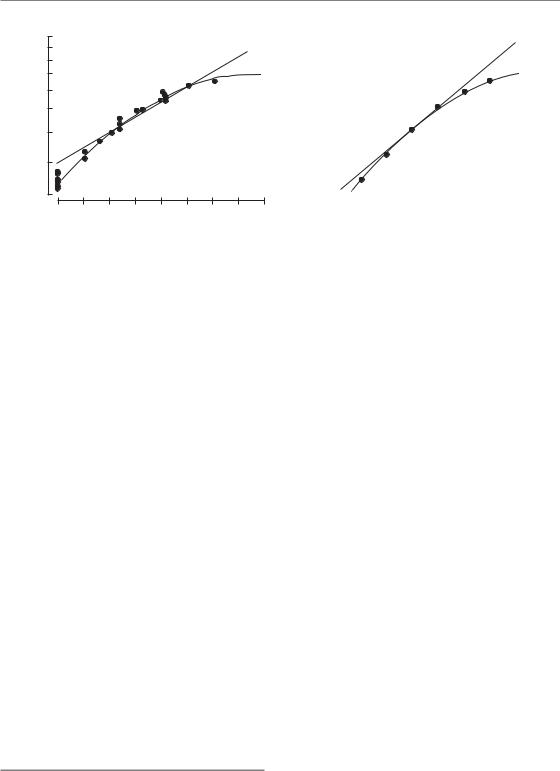
104 Fractionation: the linear-quadratic approach
Total dose (Gy)
(a)
100 |
|
|
|
|
|
|
|
|
90 |
|
|
|
|
|
|
|
|
80 |
|
|
|
|
|
|
|
|
70 |
|
|
|
|
|
|
|
(Gy) |
60 |
|
|
|
|
|
|
|
|
|
|
|
|
|
|
|
dose |
|
50 |
|
|
|
|
|
|
|
|
|
|
|
|
|
|
|
|
|
40 |
|
|
|
|
|
|
|
Total |
|
|
|
|
|
|
|
|
|
30 |
|
|
|
|
|
|
|
|
|
|
|
Dose per fraction (Gy) |
|
|
|||
20 |
16 |
10 |
6 |
3.5 |
2.0 |
1.0 |
|
|
|
|
|
|
|
|
|
|
|
1 |
2 |
4 |
8 |
16 |
32 |
64 |
128 |
256 |
|
|
Number of fractions |
|
(b) |
||||
100 |
|
|
|
|
|
|
|
|
|
|
|
|
|
|
|
|
|
|
|
|
|
|
|
|
|
|
|
|
90 |
|
|
|
|
|
|
|
|
|
|
|
|
|
|
|
|
|
|
|
|
|
|
|
|
|
|
|
|
|
|
|
|
|
|
|
|
|
|
|
|
|
|
|
|
|
|
|
|
|
|
|
|
|
|
|
|
|
80 |
|
|
|
|
|
|
|
|
|
|
|
|
|
|
|
|
|
|
|
|
|
|
|
|
|
|
|
|
|
|
|
|
|
|
|
|
|
|
|
|
|
|
|
|
|
|
|
|
|
|
|
|
|
|
|
|
|
70 |
|
|
|
|
|
|
|
|
|
|
|
|
|
|
|
|
|
|
|
|
|
|
|
|
|
|
|
|
|
|
|
|
|
|
|
|
|
|
|
|
|
|
|
|
|
|
|
|
|
|
|
|
|
|
|
|
|
60 |
|
|
|
|
|
|
|
|
|
|
|
|
|
|
|
|
|
|
|
|
|
|
|
|
|
|
|
|
|
|
|
|
|
|
|
|
|
|
|
|
|
|
|
|
|
|
|
|
|
|
|
|
|
|
|
|
|
50 |
|
|
|
|
|
|
|
|
|
|
|
|
|
|
|
|
|
|
|
|
|
|
|
|
|
|
|
|
|
|
|
|
|
|
|
|
|
|
|
|
|
|
|
|
|
|
|
|
|
|
|
|
|
|
|
|
|
40 |
|
|
|
|
|
|
|
|
|
|
|
|
|
|
|
|
|
|
|
|
|
|
|
|
|
|
|
|
|
|
|
|
|
|
|
|
|
|
|
|
|
|
|
|
|
|
|
|
|
|
|
|
|
|
|
|
|
30 |
|
|
|
|
|
|
|
|
|
|
Dose per fraction (Gy) |
|
|
|
|
|
|
|||||||||||
|
|
|
|
|
|
|
|
|
|
|
|
|
|
|
|
|||||||||||||
|
|
|
|
|
|
|
|
|
|
|
|
|
|
|
|
|
||||||||||||
20 |
|
|
|
|
12 |
10 |
5.9 |
3.4 |
1.9 |
1.0 |
|
|
|
|
|
|
||||||||||||
|
|
|
|
|
|
|
|
|
|
|
|
|
|
|
|
|
|
|
|
|
|
|
|
|
|
|
|
|
1 |
2 |
4 |
8 |
16 |
32 |
64 |
128 |
256 |
||||||||||||||||||||
|
|
|
|
|
|
|
|
|
|
Number of fractions |
|
|
|
|
|
|
||||||||||||
Figure 8.2 Relationship between total dose to achieve an isoeffect and number of fractions. (a) Acute reactions in mouse skin (Douglas and Fowler, 1976), with permission. (b) Late injury in mouse kidney (Stewart et al., 1984), with permission. Note that the relationship for kidney is steeper than that for skin. The broken lines are nominal standard dose (NSD) formulae fitted to the central part of each dataset. The solid lines show the linear-quadratic (LQ) model, from which the guide to the dose per fraction has been calculated.
allow for the greater slope. A similar modification, but not necessarily by the same amount, must be made for all late-responding tissues if the NSD formulation is to be even approximately correct.
A crucial therapeutic conclusion is illustrated by these two sets of data. At both ends of the scale, in the region of large and small dose per fraction, power-law equations overestimate the actual tolerance dose (as shown by the experimental and clinical data). This means that the power-law models are unsafe in these regions, a conclusion that is well supported by clinical experience. At the present time it is strongly recommended that the LQ model should always be used, with a correctly chosen α/β ratio, to describe isoeffect dose relationships at least over the range of doses per fraction between 1 and 5 Gy. The LQ model is simple to use in clinical calculations and comparisons, and does not require the use of ‘look-up tables’. Sections 8.4–8.8 and Chapter 9 provide a straightforward guide to LQ calculations.
8.3 CELL-SURVIVAL BASIS OF THE LQ MODEL
What is the explanation for the difference between the fractionation response of earlyand
late-responding tissues which is shown in Figs 8.1 and 8.2? Figure 8.3 shows hypothetical single-dose (one-fraction) survival curves for the target cells in earlyand late-responding tissues, drawn according to the LQ equation (see Chapter 4, Fig. 4.5b). E represents the reduction in cell survival (on a logarithmic scale) that is equivalent to tissue tolerance. The total dose that would need to be given in two fractions is obtained by drawing a straight line from the origin through the survival curve at E/2 and measuring the intersection of this line with the dose axis. As shown by the dashed line labelled 2 in Fig. 8.3a, a dose of around 11 Gy takes the effect down to E/2 and (with assumed constant effect per fraction) a second 11 Gy gives the isoeffect E: the total isoeffect dose is approximately 22 Gy. This compares with a single dose of approximately 14 Gy to give the same isoeffect E, shown by the solid line. The total dose for three fractions is obtained in the same way by drawing a line through E/3 on the survival curve, and similarly for the other fraction numbers. Because the late-responding survival curve (Fig. 8.3b) is more ‘bendy’ (it has a lower α/β ratio), the isoeffective total dose increases more rapidly with increasing number of fractions than the earlyresponding tissue in which the survival curve bends less sharply.
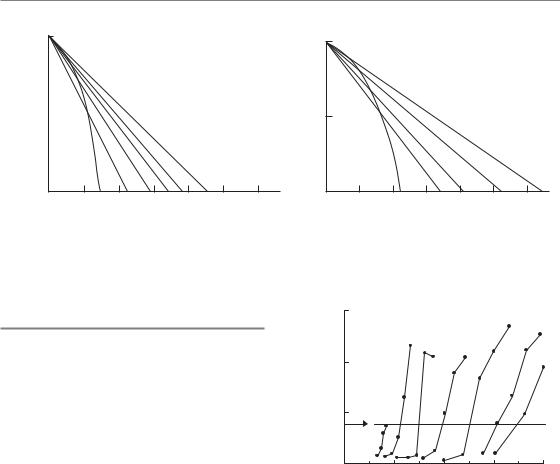
The LQ model in detail 105
Log (surviving fraction)
(a)
0 |
|
|
|
|
|
|
0 |
|
|
|
|
|
|
|
|
|
|
|
|
|
|
|
|
|
|
|
|
E |
|
|
|
|
|
|
E |
|
|
|
|
|
|
Fract. |
|
|
|
|
|
|
|
|
|
|
|
|
|
No. 1 |
2 |
3 |
5 10 |
25 |
|
|
Fract. No. |
1 |
2 |
3 |
5 |
|
8 |
E |
20 |
|
30 |
40 |
50 |
60 |
E |
20 |
30 |
|
40 |
50 |
60 |
10 |
|
10 |
|
||||||||||
|
Dose (arbitrary units) |
|
|
(b) |
Dose (arbitrary units) |
|
|
||||||
Figure 8.3 Schematic survival curves for target cells in (a) acutely responding and (b) late-responding normal tissues. The abscissa is radiation dose on an arbitrary scale. From Thames and Hendry (1987), with permission.
8.4 THE LQ MODEL IN DETAIL
The surviving fraction (SFd) of target cells after a dose per fraction d is given in Chapter 4, Section 4.10, as:
SFd exp( αd βd2)
Radiobiological studies have shown that each successive fraction in a multidose schedule is equally effective, so the effect (E) of n fractions can be expressed as:
Eloge(SFd)n n loge(SFd)
n(αd βd2)
αD βdD
where the total radiation dose D nd. This equation may be rearranged into the following forms:
1/D (α/E) (β/E)d |
(8.2) |
1/n (α/E)d (β/E)d2 |
(8.3) |
D (E/α)/[1 d/(α/β)] |
(8.4) |
The practical working of these equations may be illustrated by the results of careful fractionation experiments on the mouse kidney (Stewart et al., 1984). In these experiments, functional damage to the kidneys was measured by ethylenediaminetetraacetic acid (EDTA) clearance up to 48 weeks after irradiation with 1–64 fractions. Figure 8.4 shows the response measured as a function of total
|
15 |
|
|
|
|
|
|
mL blood |
10 |
|
|
|
|
|
|
% per |
|
|
|
|
|
|
|
Cr EDTA |
5 |
1 2 |
4 |
8 |
16 |
32 |
64 |
|
|
|
|
|
|
|
|
51 |
|
|
|
|
|
|
|
|
0 |
20 |
|
40 |
|
60 |
80 |
|
0 |
|
|
||||
|
|
Total radiation dose (Gy) |
|
||||
Figure 8.4 Dose–response curves for late damage to the mouse kidney with fractionated radiation exposure. Damage is indicated by a reduction in ethylenediaminetetraacetic acid (EDTA) clearance,
curves determined for 1–64 dose fractions, illustrating the sparing effect of increased fractionation. From Stewart et al. (1984), with permission.
radiation dose for each fraction number. To apply the LQ model to this example, we first measure off from the graph the total doses at a fixed level of effect (shown by the arrow) and then plot the reciprocal of these total doses against the corresponding dose per fraction. Equation 8.2 shows that this should give a straight line whose slope is β/E and whose intercept on the vertical axis is α/E. That this is true is shown in Fig. 8.5a: the points fit a straight line well. This line cuts the x-axis
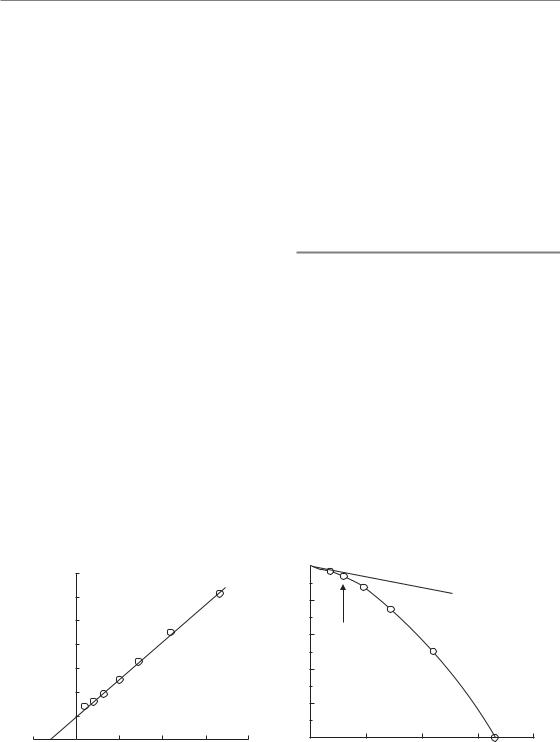
106 Fractionation: the linear-quadratic approach
at 3 Gy; it can be seen from equation 8.2 that this is equal to α/β, thus providing a measure of the α/β ratio for these data. The relative contributions of α and β to the α/β ratio can be judged by comparing the reciprocal total dose intercept (α/E) and the slope of the line (β/E).
An alternative way of deriving parameter values from these data is to plot the reciprocal of the number of fractions against the dose per fraction, as suggested by equation 8.3. Figure 8.5b shows that this gives the shape of the putative target-cell survival curve with the y-axis proportional tologe(SFd). (Statistical note: this method combined with non-linear least-squares curve fitting is preferred over the linear-regression method shown in Fig. 8.5a for determining α/β, because the 1/n and the dose-per-fraction axes are independent.) Equation 8.4 shows the LQ model in the form used already to describe the relationship between total dose and dose per fraction (Fig. 8.2).
A common clinical question is: ‘What change in total radiation dose is required when we change the dose per fraction?’. This can be dealt with very simply using the LQ approach. Rearranging equation 8.4:
E/α D[1 d/(α/β)]
For isoeffect in a selected tissue, E and α are constant. The first schedule employs a dose per fraction d1 and the isoeffective total dose is D1; we
change to a dose per fraction d2 and the new (unknown) total dose is D2. D2 is related to D1 by the equation:
D2 |
|
d1 |
(α/β) |
(8.5) |
|
D1 |
d2 |
(α/β) |
|||
|
|
This simple LQ isoeffect equation was first proposed by Withers et al. (1983). It has widely been found to be successful in clinical calculations.
8.5 THE VALUE OF α/β
Many detailed fractionation studies of the type analysed in Figs 8.2 and 8.4 have been made in animals. Table 8.1 summarizes the α/β values obtained from many of these experiments. For acutely responding tissues which express their damage within a period of days to weeks after irradiation, the α/β ratio is in the range 7–20 Gy, while for late-responding tissues, which express their damage months to years after irradiation, α/β generally ranges from 0.5 to 6 Gy. It is important to recognize that the α/βratio is not constant and its value should be chosen carefully to match the specific tissue under consideration.
Values of the α/βratio for a range of human normal tissues and tumours are given in Tables 9.1 and 13.2. The fractionation responses of well-oxygenated
Reciprocal total dose (Gy )
5
(a)
0.7 |
|
|
|
|
0.6 |
|
|
|
effect |
0.5 |
|
|
|
|
0.4 |
|
|
|
full |
|
|
|
of |
|
|
|
|
|
|
0.3 |
|
|
|
Proportion |
|
|
|
|
|
0.2 |
|
|
|
|
0.1 |
|
|
|
|
0 |
5 |
10 |
15 |
20 |
|
Dose per fraction (Gy) |
(b) |
||
0

0.2
0.4ab 3 Gy
0.6
0.8
1.0
0 |
5 |
10 |
15 |
20 |
Dose per fraction (Gy)
Figure 8.5 The data of Fig. 8.4 after two different transformations. (a) A reciprocal-dose plot according to equation 8.2.
(b) Transformation according to equation 8.3 with the same data plotted as a proportion of full effect.

Table 8.1 Values for the α/β ratio for a variety of earlyand late-responding normal tissues in experimental animals |
|
||||
|
|
|
|
|
|
Early reactions |
α/β |
References |
Late reactions |
α/β |
References |
|
|
|
|
|
|
Skin |
|
|
Spinal cord |
|
|
Desquamation |
9.1–12.5 |
Douglas and Fowler (1976) |
|
8.6–10.6 |
Joiner et al. (1983) |
|
9–12 |
Moulder and Fischer (1976) |
Jejunum |
|
|
Clones |
6.0–8.3 |
Withers et al. (1976) |
|
6.6–10.7 |
Thames et al. (1981) |
Colon
Cervical |
1.8–2.7 |
van der Kogel (1979) |
Cervical |
1.6–1.9 |
White and Hornsey (1978) |
Cervical |
1.5–2.0 |
Ang et al. (1983) |
Cervical |
2.2–3.0 |
Thames et al. (1988) |
Lumbar |
3.7–4.5 |
van der Kogel (1979) |
Lumbar |
4.1–4.9 |
White and Hornsey (1978) |
|
3.8–4.1 |
Leith et al. (1981) |
|
2.3–2.9 |
Amols, Yuhas (quoted by |
|
|
Leith et al. 1981) |
Weight loss |
9–13 |
Terry and Denekamp (1984) |
Colon |
|
|
Clones |
8–9 |
Tucker et al. (1983) |
Weight loss |
3.1–5.0 |
Terry and Denekamp (1984) |
Testis |
|
|
Kidney |
|
|
Clones |
12–13 |
Thames and Withers (1980) |
Rabbit |
1.7–2.0 |
Caldwell (1975) |
|
|
|
Pig |
1.7–2.0 |
Hopewell and Wiernik (1977) |
Mouse lethality |
|
|
Rats |
0.5–3.8 |
van Rongen et al. (1988) |
30 days |
7–10 |
Kaplan and Brown (1952) |
Mouse |
1.0–3.5 |
Williams and Denekamp (1984a,b) |
30 days |
13–17 |
Mole (1957) |
Mouse |
0.9–1.8 |
Stewart et al. (1984a) |
30 days |
11–26 |
Paterson et al. (1952) |
Mouse |
1.4–4.3 |
Thames et al. (1988) |
Tumour bed |
|
|
Lung |
|
|
45 days |
5.6–6.8 |
Begg and Terry (1984) |
LD50 |
4.4–6.3 |
Wara et al. (1973) |
|
|
|
LD50 |
2.8–4.8 |
Field et al. (1976) |
|
|
|
LD50 |
2.0–4.2 |
Travis et al. (1983) |
|
|
|
Breathing rate |
1.9–3.1 |
Parkins and Fowler (1985) |
|
|
|
Bladder |
|
|
|
|
|
Frequency, |
5–10 |
Stewart et al. (1984b) |
|
|
|
capacity |
|
|
α/β values are in grays. LD50, dose lethal to 50 per cent.
From Fowler (1989), with permission; for references, see the original.
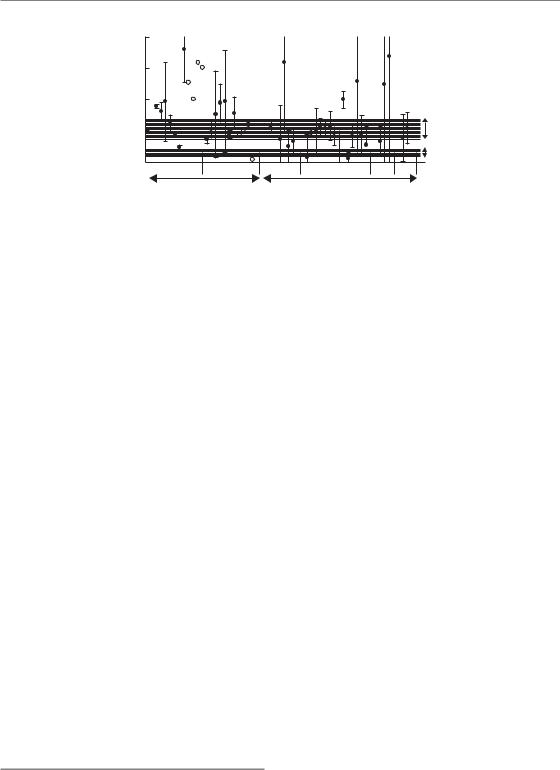
108 Fractionation: the linear-quadratic approach
a
40
30
20
10 |
|
|
|
Early |
|
0 |
|
|
|
Late |
|
clamp |
miso |
anoxic |
oxic hyp |
||
miso oxic |
|||||
In situ assay |
|
Excision assay |
|||
Figure 8.6 Values of α/β for experimental tumours, determined under a variety of conditions of oxygenation (see text). The stippled areas indicate the range of values for earlyand late-responding normal tissues. From Williams et al. (1985), with permission.
carcinomas of head and neck, and lung, are thought to be similar to that of early-responding normal tissues, sometimes with an even higher α/β ratio. However, there is evidence that some human tumour types such as melanoma and sarcomas exhibit low α/βratios, and this is also suggested for early-stage prostate and breast cancer, perhaps with α/β ratios even lower than for late normal-tissue reactions. The tumour α/βvalues shown in Fig. 8.6 were compiled by Williams et al. (1985). Values calculated from data obtained in experiments on rat and mouse tumours under fully radiosensitized conditions (marked ‘miso’ and ‘oxic’ in the Fig. 8.6) are plotted directly, and values calculated from fractionation responses under hypoxic conditions (marked ‘clamp’, ‘anoxic’ and ‘hyp’) are plotted after dividing by an assumed oxygen enhancement ratio (OER) of 2.7, because the α/β ratios for cells and tissues under anoxic and oxic conditions are in the same proportion as the OER. Error bars are estimates of the 95 per cent confidence interval on each value. Such experiments assayed the effect of radiation in situ either by regrowth delay or local tumour control or by excising the tumour from the animal and measuring the survival of cells in vitro (see Chapter 4, Section 4.4).
8.6 HYPOFRACTIONATION AND HYPERFRACTIONATION
Figure 8.7a shows the form of equation 8.5. Curves are shown for two ranges of α/β values: 1–4 Gy and 8–15 Gy, which, respectively, apply to most
lateand acute-responding tissues. It can be seen that when dose per fraction is increased above a reference level of 2 Gy, the isoeffective dose falls more rapidly for the late-responding tissues than for the early responses. Similarly, when dose per fraction is reduced below 2 Gy, the isoeffective dose increases more rapidly in the late-responding tissues. Late-responding tissues are more sensitive to a change in dose per fraction and this can be thought to reflect the greater curvature of the underlying target-cell survival curve (Section 8.3).
Since the change in total dose is greater for the lower α/β values, so is the potential for error if a wrong α/β value is used. The α/β values should therefore be selected carefully and always conservatively when doing calculations involving changing dose per fraction. Examples of the conservative choice of α/β values and other radiobiological parameters are given in Chapter 9, Sections 9.3 (Example 1), 9.5 (Example 3) and 9.12 (Example 9).
An increase in dose per fraction relative to 2 Gy is termed hypofractionation and a decrease is hyperfractionation (this use of terms may seem contradictory but it indicates that hypofractionation involves fewer dose fractions and hyperfractionation requires more fractions). We can calculate a therapeutic gain factor (TGF) for a new dose per fraction from the ratio of the relative isoeffect doses for tumour and normal tissue. An example is shown in Fig. 8.7b where the tumour is taken to have an α/β ratio of 10 Gy. Remember that we are assuming here that the new regimen is given in the same overall time as the 2 Gy regimen and that treatment is always limited by the late
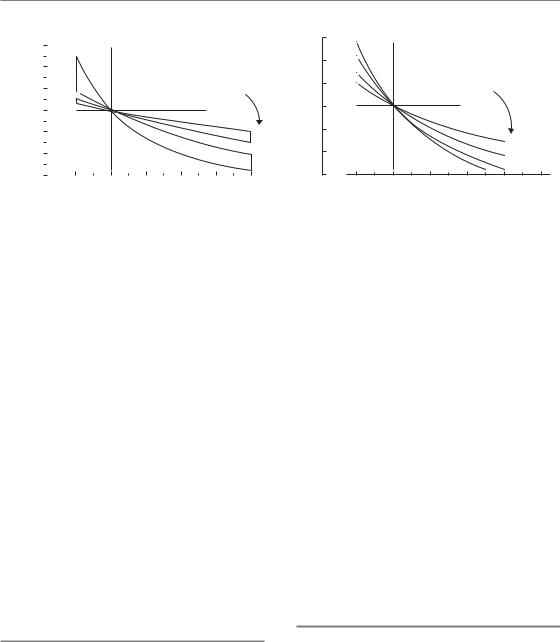
Incomplete repair 109
Ratio of total isoeffect doses
(a)
|
|
|
|
|
|
|
1.0 |
|
1 |
2 |
3 |
4 |
5 |
6 |
|
||
1.6 |
|
|
Dose per fraction (Gy) |
|
|
|||
1.4 |
|
|
|
|
|
|
|
|
1.2 |
|
|
|
|
|
a/ |
ratio |
|
1.0 |
|
|
|
|
|
|
|
|
0.8 |
|
|
|
|
|
|
15 |
|
0.6 |
|
|
|
|
|
|
8 |
|
|
|
|
|
|
|
4 |
|
|
0.4 |
|
|
|
|
|
|
|
|
Therapeutic gain factor
(b)
1.3
1.2
1.1
1.0
0.9
0.8
0.7
1.5
2
3
4
a/ ratio
4
3
2
1 |
2 |
3 |
4 |
5 |
6 |
Dose per fraction (Gy)
Figure 8.7 (a) Theoretical isoeffect curves based on the linear-quadratic (LQ) model for various α/β ratios. The outlined areas enclose curves corresponding to early-responding and late-responding normal tissues. (b) Therapeutic gain factors for various α/β ratios of normal tissue, assuming an α/β ratio of 10 Gy for tumours.
reactions. It can be seen from Fig. 8.7 that hyperfractionation is predicted to give a therapeutic gain, and hypofractionation a therapeutic loss. Note, however, that hypofractionation may be used as a convenient way of accelerating treatment (i.e. shortening the overall treatment time). At least in some tumour types, this can lead to short intensive schedules that compare favourably with more protracted schedules in terms of both tumour control and late normal-tissue effects. Note, also, that the theoretical advantage of low dose per fraction would be nullified, or even reversed, for specific tumours that have low / ratios. If an unacceptable increase in acute normal-tissue reactions prevented the total dose from being increased to the full tolerance of the late-responding tissues, the therapeutic gain for hyperfractionation would also be less than shown in Fig. 8.7b.
choice and can be achieved using a specific version of equation 8.5:
EQD2 |
D |
d |
(α/β) |
(8.6) |
|
(α/ β) |
|||
|
2 |
|
||
where EQD2 is the dose in 2-Gy fractions that is biologically equivalent to a total dose D given with a fraction size of d Gy. Values of EQD2 may be numerically added for separate parts of a treatment schedule. They have the advantage that since 2 Gy is a commonly used dose per fraction clinically, EQD2 values will be recognized by radiotherapists as being of a familiar size. The EQD2 is identical to the normalized total dose (NTD) proposed by Withers et al. (1983); see also Maciejewski et al. (1986).
8.7 EQUIVALENT DOSE IN 2-GY FRACTIONS (EQD2)
The LQ approach leads to various formulae for calculating isoeffect relationships for radiotherapy, all based on similar underlying assumptions. These formulae seek to describe a range of fractionation schedules that are isoeffective. The simplest method of comparing the effectiveness of schedules consisting of different total doses and doses per fraction is to convert each schedule into an equivalent schedule in 2-Gy fractions which would give the same biological effect. This is the approach that we recommend as the method of
8.8 INCOMPLETE REPAIR
The simple LQ model described by equations 8.1–8.6 assumes that sufficient time is allowed between fractions for complete repair of sublethal damage to take place after each dose. This fullrepair interval is at least 6 hours but in some cases (e.g. spinal cord) may be as long as 1 day (see Chapter 9, Section 9.4). If the interfraction interval is reduced below this value, for example when multiple fractions per day are used, the overall damage from the whole treatment is increased because the repair (or more correctly, recovery) of damage caused by one radiation dose may not be complete
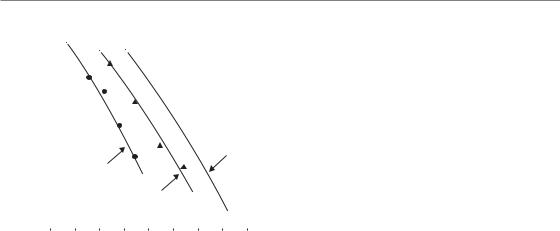
110 Fractionation: the linear-quadratic approach
per circumference |
100 |
|
|
|
|
|
|
|
|
|
|
|
|
|
|
|
|
|
|
|
|
|
|
|
|
|
|
|
|
|
|
|
|
|
|
|
|
|
|
|
|
|
|
|
|
|
|
|
|
|
|
|
|
|
|
|
|
|
|
|
|
|
|
|
|
|
|
|
|
|
|
|
|
|
|
|
|
|
|
|
|
|
|
|
|
|
|
|
|
||
10 |
|
|
|
|
|
|
|
|
|
|
|
|
|
|
|
|
|
|
|
|
|
|
|
|
|
|
|
|
|
|
|
|
|
|
|
|
|
|
|
|
|
|
|
|
|
|
|
|
|
|
|
|
|
|
|
|
|
|
|
|
|
|
|
|
|
|
|
|
|
|
|
|
|
|
|
|
|
|
|
|
|
|
|
|
|
|
|
|
|
||
|
|
|
|
|
|
|
|
|
|
|
|
|
|
|
|
|
|
|
|
|
|
|
|
|
|
|
|
|
|
|
|
|
|
|
|
|
|
|
|
|
|
|
|
||
|
|
|
|
|
|
|
|
|
|
|
|
|
|
|
|
|
|
|
|
|
|
|
|
|
|
|
|
|
|
|
|
|
|
|
|
|
|
|
|
|
|
|
|
||
|
|
|
|
|
|
|
|
|
|
|
|
|
|
|
|
|
|
|
|
|
|
|
|
|
|
|
|
|
|
|
|
|
|
|
|
|
|
|
|
|
|
|
|
||
|
|
|
|
|
|
|
|
|
|
|
|
|
|
|
|
|
|
|
|
|
|
|
|
|
|
|
|
|
|
|
|
|
|
|
|
|
|
|
|
|
|
|
|
||
cells |
|
|
|
|
|
|
|
|
|
|
|
|
|
|
|
|
|
|
|
|
|
|
|
|
|
|
|
|
|
|
|
|
|
|
|
|
|
|
|
6hours |
|||||
|
|
|
|
|
|
|
|
|
|
|
|
|
|
|
|
|
|
|
|
|
|
|
|
|
|
|
|
|
|
|
|
|
|
|
|
|
|
|
|||||||
Surviving |
1 |
|
|
|
|
|
0.5 hour |
|
|
|
|
|
|
1hour |
|
|
|
|
|
|
|
|
|||||||||||||||||||||||
|
|
|
|
|
|
|
|
|
|
|
|
|
|
|
|
|
|
|
|
|
|
|
|
|
|||||||||||||||||||||
|
|
|
|
|
|
|
|
|
|
|
|
|
|
|
|
|
|
|
|
|
|
|
|
|
|||||||||||||||||||||
|
|
|
|
|
|
|
|
|
|
|
|
|
|
|
|
|
|
|
|
|
|
|
|
|
|
||||||||||||||||||||
|
|
|
|
|
|
|
|
|
|
|
|
|
|
|
|
|
|
|
|
|
|
|
|
|
|
||||||||||||||||||||
|
|
|
|
|
|
|
|
|
|
|
|
|
|
|
|
|
|
|
|
|
|
|
|
|
|
|
|
|
|
|
|
|
|
|
|
|
|
||||||||
|
|
|
|
|
|
|
|
|
|
|
|
|
|
|
|
|
|
|
|
|
|
|
|
|
|
|
|
|
|
|
|
|
|
|
|
|
|
||||||||
|
|
|
|
|
|
|
|
|
|
|
|
|
|
|
|
|
|
|
|
|
|
|
|
|
|
|
|
|
|
|
|
|
|
|
|
|
|
||||||||
|
|
|
|
|
|
|
|
|
|
|
|
|
|
|
|
|
|
|
|
|
|
|
|
|
|
|
|
|
|
|
|
|
|
|
|
|
|
|
|
|
|
|
|
|
|
|
|
|
|
|
|
|
|
|
|
|
|
|
|
|
|
|
|
|
|
|
|
|
|
|
|
|
|
|
|
|
|
|
|
|
|
|
|
|
|
|
|
|
|
|
|
|
|
|
|
|
|
|
|
|
|
|
|
|
|
|
|
|
|
|
|
|
|
|
|
|
|
|
|
|
|
|
|
|
|
|
|
|
|
|
|
|
|
|
|
|
|
|
12 |
14 |
16 |
18 |
|
20 |
|
22 |
|
|
|
24 |
26 |
28 |
30 |
||||||||||||||||||||||||||||||
|
|
|
|
|
|
|
|
|
Total radiation dose (Gy) |
|
|
|
|
|
|
|
|||||||||||||||||||||||||||||
Figure 8.8 Effect of interfraction interval on intestinal radiation damage in mice. The total dose required in five fractions for a given level of effect is less for short intervals, illustrating incomplete repair between fractions. From Thames et al. (1984), with permission.
before the next fraction is given, and there is then interaction between residual unrepaired damage from one fraction and the damage from the next fraction. As an example of this process, Fig. 8.8 shows data from mouse jejunum irradiated with five X-ray fractions in which the number of surviving crypts per gut circumference is plotted against total dose. Much less dose is needed to produce the same effects when the interfraction interval is reduced from 6 hours to 1 hour or 0.5 hour. This process is called incomplete repair.
The influence of incomplete repair is determined by the repair halftime (T 1/2) in the tissue. This is the time required between fractions, or during low dose-rate treatment, for half the maximum possible repair to take place. Incomplete repair will tend to reduce the isoeffective dose and corrections have to be made for the consequent loss of tolerance. This can be accomplished by the use of the incomplete repair model as introduced by Thames (1985). In this model, the amount of unrepaired damage is expressed by a function Hm which depends upon the number of equally spaced fractions (m), the time interval between them and the repair halftime. For the purpose of
tolerance calculations the extra Hm term is added to the basic EQD2 formula thus:
EQD2 |
D |
d(1 Hm ) (α/β) |
|
|
(α/β) |
||
|
2 |
||
(8.7; fractionated)
Once again, d is the dose per fraction and D the total dose. If repair from one day to the next is assumed to be complete, m is the number of fractions per day. Values of Hm are given in Table 8.2 for repair halftimes up to 5 hours and for two or three fractions per day given with interfraction intervals down to 3 hours. Other values can be calculated using the formulae given in the Appendix. Some clinical datasets have suggested even longer repair half-times for late reactions (Bentzen et al., 1999). In that case, repair cannot be assumed to be complete in the interval between the last fraction in a day and the first fraction the following day, and a more general version of the incomplete-repair LQ model will have to be used (Guttenberger et al., 1992). Table 8.4 shows values of T1/2 for some normal tissues in laboratory animals and the available values for human normal-tissue endpoints are summarized in Table 9.2. [Advanced note: in several cases, experiments have indicated that repair has fast and slow components. The EQD2 equation above [and biologically effective dose (BED) and total effect (TE) formulae] have to be reformulated in a more complex form to take account of these cases (Millar and Canney, 1993).]
Figure 8.9 demonstrates the fit of the incomplete repair LQ model to data for pneumonitis in mice following fractionated thoracic irradiation with intervals of 3 hours between doses (Thames et al., 1984). The endpoint was mortality, expressed as the LD50 (radiation dose to produce lethality in 50 per cent of subjects). In these reciprocal-dose plots, incomplete repair makes the data bow upwards away from the straight line (dashed), which shows the pure LQ relationship that would be obtained when there is complete repair between successive doses, as would be the case with long time-intervals between fractions. An estimate of the repair halftime can be found by fitting data of the type shown in Figs 8.8 and 8.9 with the incomplete repair LQ model and seeking the T1/2 value that gives the best fit.
Table 8.2 |
Incomplete repair factors: fractionated irradiation (Hm factors) |
|
|
|
|
|
|
|
|
|
|
|
|
|||||
Repair |
|
|
Interval for m 2 fractions per day |
|
|
|
|
Interval for m 3 fractions per day |
|
|
|
|
||||||
halftime |
3 |
4 |
5 |
6 |
8 |
10 |
3 |
4 |
5 |
|
6 |
8 |
|
|||||
(hours) |
|
|
|
|
|
|
|
|
|
|
|
|
|
|
|
|
|
|
|
|
|
|
|
|
|
|
|
|
|
|
|
|
|
|
|||
0.50 |
0.016 |
0.004 |
0.001 |
0.000 |
0.000 |
0.000 |
0.021 |
0.005 |
0.001 |
|
0.000 |
0.000 |
|
|||||
0.75 |
0.063 |
0.025 |
0.010 |
0.004 |
0.001 |
0.000 |
0.086 |
0.034 |
0.013 |
|
0.005 |
0.001 |
|
|||||
1.00 |
0.125 |
0.063 |
0.031 |
0.016 |
0.004 |
0.000 |
0.177 |
0.086 |
0.042 |
|
0.021 |
0.005 |
|
|||||
1.25 |
0.190 |
0.109 |
0.063 |
0.036 |
0.012 |
0.004 |
0.277 |
0.153 |
0.086 |
|
0.049 |
0.016 |
|
|||||
1.50 |
0.250 |
0.158 |
0.099 |
0.063 |
0.025 |
0.010 |
0.375 |
0.227 |
0.139 |
|
0.086 |
0.034 |
|
|||||
2.00 |
0.354 |
0.250 |
0.177 |
0.125 |
0.063 |
0.031 |
0.555 |
0.375 |
0.257 |
|
0.177 |
|
|
|
||||
|
0.086 |
|||||||||||||||||
2.50 |
0.435 |
0.330 |
0.250 |
0.190 |
0.109 |
0.063 |
0.707 |
0.512 |
0.375 |
|
0.277 |
|
0.153 |
|||||
3.00 |
0.500 |
0.397 |
0.315 |
0.250 |
0.158 |
0.099 |
0.833 |
0.634 |
|
|
|
|
|
0.227 |
||||
0.486 |
|
0.375 |
|
|||||||||||||||
4.00 |
|
0.595 |
0.500 |
0.420 |
0.354 |
0.250 |
0.177 |
1.029 |
0.833 |
|
0.678 |
|
0.555 |
|
0.375 |
|||
5.00 |
|
0.660 |
0.574 |
0.500 |
0.435 |
0.330 |
0.250 |
1.170 |
0.986 |
|
0.833 |
|
0.707 |
|
0.512 |
|
||
|
|
|
|
|
|
|
|
|
|
|
|
|
|
|
|
|
|
|
Shaded cells in the table: the approximation of complete overnight repair is less precise here and this affects the precision of biological dose estimates.
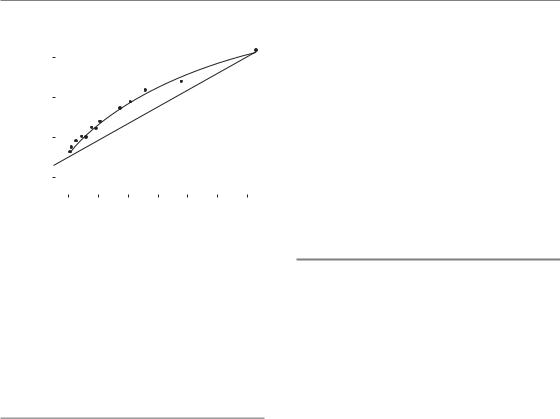
112 Fractionation: the linear-quadratic approach
) |
0.08 |
|
|
|
|
|
|
|
|
|
|
|
|
|
Incomplete repair |
|
|
|
|
|
|
|
|
|
|
|
|||||||||||||||
|
|
|
|
|
|
|
|
|
|
|
|
|
|
|
|
|
|
|
|
|
|
|
|
||||||||||||||||||
|
|
|
|
|
|
|
|
|
|
|
|
|
|
|
|
|
|
|
|
|
|
|
|
|
|||||||||||||||||
|
|
|
|
|
|
|
|
|
|
|
|
|
|
|
|
|
|
|
|
|
|
|
|
|
|||||||||||||||||
|
|
|
|
|
|
|
|
|
|
|
|
|
|
|
|
|
|
|
|
|
|
|
|
|
|
||||||||||||||||
(Gy |
0.06 |
|
|
|
|
|
|
|
|
|
|
|
|
|
|
|
|
|
|
|
|
|
|
|
|
|
|
|
|
|
|
|
|
|
|
|
|
|
|
|
|
50 |
|
|
|
|
|
|
|
|
|
|
|
|
|
|
|
|
|
|
|
|
|
|
|
|
|
|
|
|
|
|
|
|
|
|
|
|
|
|
|
|
|
LD |
0.04 |
|
|
|
|
|
|
|
|
|
|
|
|
|
|
|
|
|
|
|
|
|
|
|
|
|
|
Complete repair |
|
|
|
|
|||||||||
|
|
|
|
|
|
|
|
|
|
|
|
|
|
|
|
|
|
|
|
|
|
|
|
|
|
|
|
|
|
||||||||||||
of |
|
|
|
|
|
|
|
|
|
|
|
|
|
|
|
|
|
|
|
|
|
|
|
|
|
|
|
|
|
|
|||||||||||
Reciprocal |
0.02 |
|
|
|
|
|
|
|
|
|
|
|
|
|
|
|
|
|
|
|
|
|
|
|
|
|
|
|
|
|
|
|
|
|
|
|
|
|
|
|
|
|
|
|
|
|
|
|
|
|
|
|
|
|
|
|
|
|
|
|
|
|
|
|
|
|
|
|
|
|
|
|
|
|
|
|
|
|
|
|
|
||
|
|
|
|
|
|
|
|
|
|
|
|
|
|
|
|
|
|
|
|
|
|
|
|
|
|
|
|
|
|
|
|
|
|
|
|
|
|
|
|
|
|
|
|
|
|
|
|
|
|
|
|
|
|
|
|
|
|
|
|
|
|
|
|
|
|
|
|
|
|
|
|
|
|
|
|
|
|
|
|
|
|
|
|
|
0 |
|
|
|
|
|
|
|
|
|
|
|
|
|
|
|
|
|
|
|
|
|
|
|
|
|
|
|
|
|
|
|
|
|
|
|
|
|
|
|
|
|
|
2 |
4 |
6 |
8 |
10 |
12 |
1 |
|||||||||||||||||||||||||||||||||
|
0 |
||||||||||||||||||||||||||||||||||||||||
Dose per fraction (Gy)
Figure 8.9 Reciprocal dose plot (compare Fig. 8.5a) of data for pneumonitis in mice produced by fractionated irradiation; the points derive from experiments with different dose per fraction (and therefore different fraction numbers), always with 3 hours between doses. The upward bend in the data illustrates lack of sparing because of incomplete repair. From Thames et al. (1984), with permission.
Continuous irradiation
Another common situation in which incomplete repair occurs in clinical radiotherapy is during continuous irradiation. As described in Chapter 12, irradiation must be given at a very low dose rate (below about 5 cGy/hour) for full repair to occur during irradiation. At the other extreme, a single irradiation at high dose rate may not allow any significant repair to occur during exposure. As the dose rate is reduced below the high dose-rate range used in external-beam radiotherapy, the duration of irradiation becomes longer and the induction of DNA damage is counteracted by repair, leading to an increase in the isoeffective dose. The corresponding EQD2 formula for continuous irradiation incorporates a factor g to allow for incomplete repair:
EQD2 |
D |
dg (α/β) |
(8.8; contiuous |
|||
2 |
(α/β) |
|
low dose rate) |
|||
|
|
|||||
where D is the total dose ( dose rate time). The parameter d is retained, as in the equation for fractionated radiotherapy, in order to deal with fractionated low dose-rate exposures. For a single
continuous exposure d D. This equation assumes that there is full recovery between the low dose-rate exposures; if not, the Hm factor must also be added (see Appendix). Table 8.3 gives values of the g factor for exposure times between 1 hour and 4 days.
The simple LQ model has also been applied to, for example, permanent interstitial implants and to biologically targeted radionuclide therapy. The interested reader is referred to the book by Dale and Jones (2007) listed under Further reading.
8.9 SHOULD A TIME FACTOR BE INCLUDED?
If the overall duration of fractionated radiotherapy is increased there will usually be greater repopulation of the irradiated tissues, both in the tumour and in early-reacting normal tissues. So far, we have not discussed the change in total dose necessary to compensate for changes in the overall duration of treatment. Overall time was included in the now-obsolete NSD and TDF models but is not put into the basic LQ approach described above. The reason for this is because the time factor in radiotherapy is now perceived to be more complex than had previously been supposed. For example, Fig. 8.10 shows that the extra dose needed to counteract proliferation in mouse skin does not become significant until about 2 weeks after the start of daily fractionation. In this and other situations, the time factor in the old NSD formula
(Fig. 8.10; broken line: total dose T 0.11) gives a false picture because it predicts a large amount of sparing if the overall time was increased from 1 to 12 days. These wrong time factors also underestimate the dose required to compensate for planned or unplanned gaps in treatment. Thus a T 0.11 factor predicts only an 8 per cent increase in total dose for a doubling of overall time, for example from 3.5 to 7 weeks. This would correspond to a 5.6 Gy increase in the total dose for a schedule delivering, say, 70 Gy to a squamous cell carcinoma of the head and neck. Clinical data summarized in Chapter 9 suggest that in this tumour type an additional dose of 16 Gy will be required to compensate for a 3.5-week prolongation of treatment time.
The use of the LQ model in clinical practice with no time factor at all is probably the best strategy for late-reacting tissues because any extra dose
Table 8.3 Incomplete repair factors: continuous irradiation (g factors)
Repair |
Exposure time (hours) |
|
|
|
|
Exposure time (days) |
|
|
|
|
|
|
|||
halftime |
1 |
2 |
3 |
4 |
8 |
12 |
|
1 |
1.5 |
2 |
2.5 |
3 |
3.5 |
4 |
|
(hours) |
|
|
|
|
|
|
|
|
|
|
|
|
|
|
|
|
|
|
|
|
|
|
|
|
|
|
|
|
|
|
|
0.50 |
0.662 |
0.477 |
0.367 |
0.296 |
0.164 |
0.113 |
0.058 |
0.039 |
0.030 |
0.024 |
0.020 |
0.017 |
0.015 |
|
|
0.75 |
0.752 |
0.589 |
0.477 |
0.398 |
0.234 |
0.164 |
0.086 |
0.058 |
0.044 |
0.035 |
0.030 |
0.025 |
0.022 |
|
|
1.00 |
0.804 |
0.662 |
0.557 |
0.477 |
0.296 |
0.212 |
0.113 |
0.077 |
0.058 |
0.047 |
0.039 |
0.034 |
0.030 |
|
|
1.25 |
0.838 |
0.714 |
0.616 |
0.539 |
0.350 |
0.255 |
0.139 |
0.095 |
0.072 |
0.058 |
0.049 |
0.042 |
0.037 |
|
|
1.50 |
0.862 |
0.752 |
0.662 |
0.589 |
0.398 |
0.296 |
0.164 |
0.113 |
0.086 |
0.070 |
0.058 |
0.050 |
0.044 |
|
|
2.00 |
0.894 |
0.804 |
0.728 |
0.662 |
0.477 |
0.367 |
0.212 |
0.147 |
0.113 |
0.092 |
0.077 |
0.066 |
0.058 |
|
|
2.50 |
0.914 |
0.838 |
0.772 |
0.714 |
0.539 |
0.427 |
0.255 |
0.180 |
0.139 |
0.113 |
0.095 |
0.082 |
0.072 |
|
|
3.00 |
0.927 |
0.862 |
0.804 |
0.752 |
0.589 |
0.477 |
0.296 |
0.212 |
0.164 |
0.134 |
0.113 |
0.098 |
0.086 |
|
|
4.00 |
0.945 |
0.894 |
0.847 |
0.804 |
0.662 |
0.557 |
0.367 |
0.269 |
0.212 |
0.174 |
0.147 |
0.128 |
0.113 |
|
|
5.00 |
0.955 |
0.914 |
0.875 |
0.838 |
0.714 |
0.616 |
0.427 |
0.321 |
0.255 |
0.212 |
0.180 |
0.157 |
0.139 |
|
|
|
|
|
|
|
|
|
|
|
|
|
|
|
|
|
|
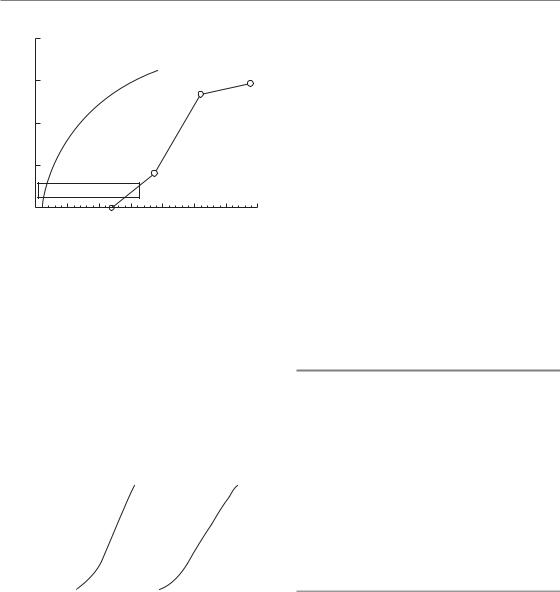
114 Fractionation: the linear-quadratic approach
|
20 |
|
|
|
|
|
|
|
(Gy) |
15 |
|
|
|
|
|
|
|
required |
10 |
T 0.11 |
|
|
|
|
|
|
|
|
|
|
|
|
|
||
dose |
|
|
|
|
|
1.3 Gy/day |
|
|
Extra |
5 |
|
|
|
|
|
|
|
|
|
|
|
|
|
|
|
|
|
|
14 |
|
|
|
|
|
|
|
0 |
|
|
|
|
|
|
|
|
0 |
5 |
10 |
15 |
20 |
25 |
30 |
35 |
Time after first fraction (days)
Figure 8.10 Extra dose required to counteract proliferation in mouse skin. Test doses of radiation were given at various intervals after a priming treatment with fractionated radiation. Proliferation begins about 12 days after the start of irradiation and is then equivalent to an extra dose of approximately 1.3 Gy/day. The broken line shows the prediction of the nominal standard dose (NSD) equation. Data from Denekamp (1973).
(Gy) |
20 |
|
|
|
|
Early reaction |
|
|
Late reaction |
|||||||
|
|
|
|
|
|
|||||||||||
15 |
|
|
|
|
( |
|||||||||||
|
|
|
|
|||||||||||||
required |
|
|
|
|
( |
|
|
|
|
|
|
) |
||||
10 |
|
|
|
|
|
|
|
|
|
|
|
|
|
|
|
|
|
|
|
|
|
|
|
|
|
|
|
|
|
|
|
||
dose |
|
|
|
|
|
|
|
|
|
|
|
|
|
|
|
|
Extra |
5 |
|
|
|
|
|
|
|
|
|
|
|
|
|
|
|
|
|
|
|
|
|
|
|
|
|
|
|
|
|
|
|
|
|
0 |
|
|
|
|
|
|
|
|
|
|
|
|
|
|
|
|
|
|
|
|
|
|
|
|
|
|
|
|
|
|
|
|
|
|
10 |
20 |
30 |
40 |
50 |
60 |
70 |
||||||||
|
0 |
|||||||||||||||
Days after start of irradiation
Figure 8.11 Schematic diagram showing that the extra dose required to counteract proliferation does not become significant until much later for late-responding normal tissues, such as spinal cord, beyond the 6-week duration of conventional radiotherapy. From Fowler (1984), with permission.
needed to counteract proliferation does not become significant until beyond the overall time of treatment, even up to 6 weeks. This is illustrated schematically in Fig. 8.11, which compares
the different effects of overall time in earlyand late-responding tissues. Attempts have been made to include time factors in the LQ model for earlyresponding normal tissues and tumours, but such factors depend in a complex way on the dose per fraction and interfraction interval as well as on the tissue type, and have to take account of any delay in onset of proliferation which may depend in some way on these factors also. We therefore recommend considering the influence of changing overall time on radiotherapy as a separate problem from the effect of changing the dose per fraction, which can be done in a straightforward way using the LQ model as described here. The practical approaches to handling changes in overall time are described in Chapters 9–11.
8.10 ALTERNATIVE ISOEFFECT FORMULAE BASED ON THE LQ MODEL
Two other formulations that can be used for comparing schedules with differing doses per fraction are the concepts of extrapolated tolerance dose (ETD) introduced by Barendsen (1982) and ‘total effect’ (TE) described by Thames and Hendry (1987). Both of these methods are mathematically (and biologically) equivalent to the EQD2 concept, but are mentioned here because they have found some use in the literature.
Extrapolated total dose or biologically effective dose
Both the ETD and the biologically effective dose (BED) are mathematically identical concepts. Fowler (1989) preferred the term BED because it can logically be understood to refer to levels of effect that are below normal-tissue tolerance, whereas the term ETD implies the full tolerance effect. First, we must define a particular effect, or endpoint. Although the validity of the LQ approach to fractionation depends principally on its ability to predict isoeffective schedules successfully, there is an implicit assumption that the isoeffect has a direct relationship with a certain level of cell inactivation [or final cell survival (SFd)n].

Alternative isoeffect formulae based on the LQ model 115
Table 8.4 Halftimes for recovery from radiation damage in normal tissues of laboratory animals
Tissue |
Species |
Dose delivery |
T1/2 (hours) |
Source |
Haemopoietic |
Mouse |
CLDR |
0.3 |
Thames et al. (1984) |
Spermatogonia |
Mouse |
CLDR |
0.3–0.4 |
Delic et al. (1987) |
Jejunum |
Mouse |
F |
0.45 |
Thames et al. (1984) |
|
Mouse |
CLDR |
0.2–0.7 |
Dale et al. (1988) |
Colon (acute injury) |
Mouse |
F |
0.8 |
Thames et al. (1984) |
|
Rat |
F |
1.5 |
Sassy et al. (1988) |
Lip mucosa |
Mouse |
F |
0.8 |
Ang et al. (1985) |
|
Mouse |
CLDR |
0.8 |
Scalliet et al. (1987) |
|
Mouse |
FLDR |
0.6 |
Stüben et al. (1991) |
Tongue epithelium |
Mouse |
F |
0.75 |
Dörr et al. (1993) |
Skin (acute injury) |
Mouse |
F |
1.5 |
Rojas et al. (1991) |
|
Mouse |
CLDR |
1.0 |
Joiner et al. |
|
|
|
|
(unpublished) |
|
Pig |
F |
0.4 1.2* |
van den Aardweg |
|
|
|
|
and Hopewell (1992) |
|
Pig |
F |
0.2 6.6* |
Millar et al. (1996) |
Lung |
Mouse |
F |
0.4 4.0* |
van Rongen et al. (1993) |
|
Mouse |
CLDR |
0.85 |
Down et al. (1986) |
|
Rat |
FLDR |
1.0 |
van Rongen (1989) |
Spinal cord |
Rat |
F |
0.7 3.8* |
Ang et al. (1992) |
|
Rat |
CLDR |
1.4 |
Scalliet et al. (1989) |
|
Rat |
CLDR |
1.43 |
Pop et al. (1996) |
Kidney |
Mouse |
F |
1.3 |
Joiner et al. (1993) |
|
Mouse |
F |
0.2 5.0 |
Millar et al. (1994) |
|
Rat |
F |
1.6–2.1 |
van Rongen et al. (1990) |
Rectum (late injury) |
Rat |
CLDR |
1.2 |
Kiszel et al. (1985) |
Heart |
Rat |
F |
3 |
Schultz-Hector et al. (1992) |
Dose delivery: F, acute dose fractions, FLDR, fractionated low dose rate; CLDR, continuous low dose rate.
*Two components of repair with different halftimes.
Generally, the fraction of surviving cells associated with an isoeffect is unknown and it is customary to work in terms of a level of tissue effect, which we denote as E. From equation 8.4:
E/α D[1 d/(α/β)] BED
BED is a measure of the effect (E) of a course of fractionated or continuous irradiation; when divided by α it has the units of dose and is usually expressed in grays. Note that as the dose per fraction (d) is reduced towards zero, BED becomes
D nd (i.e. the total radiation dose). Thus, BED is the theoretical total dose that would be required to produce the isoeffect E using an infinitely large number of infinitesimally small dose fractions. It is therefore also the total dose required for a single exposure at very low dose rate (see Chapter 12, Section 12.5). As with the simpler concept of EQD2, values of BED from separate parts of a course of treatment may be added in order to calculate the overall BED value. A disadvantage of BED as a measure of treatment intensity is that it

116 Fractionation: the linear-quadratic approach
is numerically much greater than any prescribable radiation dose of fractionated radiotherapy and is therefore difficult to relate to everyday clinical practice, which is the main reason why we recommend the use of EQD2 in this book.
Total effect
The total effect (TE) formulation is conceptually similar to BED and has also been used in the literature. In this case, we divide E by β rather than α, to get
E/β D[(α/β) d] TE
The units of TE are Gy2, which again means that the TE values have no simple interpretation. The TE isoeffect formulae are similar to the EQD2 formulae except that the denominator (2 α/β) is omitted. This has the computational advantage that division by this factor is done only for the final TE value and not for any intermediate calculations. However, it has the disadvantage that these intermediate results are not recognizable doses, and we recommend the EQD2 method instead as a means of making it easier to detect numerical errors in the calculation process.
8.11 LIMITS OF APPLICABILITY OF THE SIMPLE LQ MODEL, ALTERNATIVE MODELS
Uncritical application of the LQ model in clinical situations could potentially compromise the safety of a patient. Extrapolation of experience from a standard regimen to a regimen using a considerably changed overall treatment time or dose per fraction should only be attempted with great care. This is partly because of a limited precision in the radiobiological parameters of the LQ model which will be ‘blown up’ when extrapolation between very diverse schedules is performed. But even if the parameters of the model were known with high precision, some limitations to the use of the LQ model are suggested by laboratory experiments.
At a dose per fraction of less than 1.0 Gy, the phenomenon of low-dose hyper-radiosensitivity (HRS; see Chapter 4, Section 4.14) – provided that
it exists in the critical normal tissues and tumours in humans – would mean that using the standard LQ model could considerably underestimate the biological effect of a given total dose. This could potentially affect the estimated biological effect of some intensity-modulated radiation therapy (IMRT) dose distributions where a relatively large normal-tissue volume may be irradiated with a dose per fraction in the HRS range (Honore and Bentzen, 2006). A modified form of the LQ formula has been derived (Chapter 4, equation 4.6) but the model parameters are not yet known with any useful precision for human tissues and tumours.
Also, at very high dose per fraction the mathematical form of the LQ model is unlikely to be correct. While the LQ survival curve represents a continuously bending parabola in a plot of the logarithm of surviving fraction versus dose, a number of in vitro and in vivo datasets suggest that the empirical survival curve asymptotically approaches a straight line. Several attempts have been made to extend the LQ model to high doses per fraction as well, all of them leading to the inclusion of at least one additional parameter in the model, as described in Chapter 4, Section 4.13 (Lind et al., 2003; Guerrero and Li, 2004). None of these models have found wider applications in the analysis of clinical data, at least so far, the obvious limitation being that most clinical datasets have insufficient resolution to allow the estimation of three model parameters. It is difficult to give a specific dose per fraction beyond which the simple LQ model should not be used, but extrapolations beyond 5–6 Gy per fraction are likely to lack clinically useful precision.
8.12 BEYOND THE TARGET CELL HYPOTHESIS
The target cell hypothesis dominated much of radiobiological thinking for almost half a century. As described above, this hypothesis played a key role in formulating the LQ formulae. More recently, the importance of damage processing and tissue remodelling in the pathogenesis of late effects have been recognized (see Chapter 13 and review by Bentzen, 2006). In addition, basic radiobiology studies have revealed non-targeted effects of ionizing radiation, such as the ‘bystander’

Bibliography 117
response induced in cells in the vicinity of a cell hit by ionizing radiation (Prise et al., 2005). All of this has not restricted the clinical utility of the LQ formula. Equation 8.5 can usefully be viewed as an operational definition of α/β and a formula allowing practical correction for the change in biological effect as a function of dose per fraction. The application of this formula does not depend on the biological reality of target cells. Chapter 9 will pursue this more pragmatic or ‘data-driven’ approach to the LQ model in the clinic.
altered dose per fraction, assuming the new and old treatments are given in the same overall time. For late reactions it is usually unnecessary to modify total dose in response to a change in overall time, but for early reactions (and for tumour response) a correction for overall treatment time should be included. Although the effect of time on biological effect is complex, simple linear corrections have been shown to be of some value (see Chapters 10 and 11).
Key points
1.The LQ model satisfactorily describes the relationship between total isoeffective dose and dose per fraction over the range of dose per fraction from 1 Gy up to 5–6 Gy. In contrast, power-law formulae can only be made to fit data over a limited range of dose per fraction.
2.The α/β ratio describes the shape of the fractionation response: a low α/β(0.5–6 Gy) is usually characteristic of late-responding normal tissues and indicates a rapid increase of total dose, with decreasing dose per fraction and a survival curve for the putative target cells that is significantly curved.
3.A higher α/β ratio (7–20 Gy) is usually characteristic of early-responding normal tissues and rapidly-proliferating carcinomas; it indicates a less significant increase in total dose with decreasing dose per fraction and a less curved cell-survival response for the putative target cells.
4.The EQD2 formulae provide a simple and convenient way of calculating isoeffective radiotherapy schedules, based on the LQ
model. Tolerance calculations always require an estimate of the α/β ratio to be included.
5.For short interfraction intervals, a correction may be necessary for incomplete repair.
When using the EQD2 formulae to calculate schedules with multiple fractions per day or continuous low dose rate, an estimate of the repair halftime must also be included.
6.The basic LQ model is appropriate for calculating the change in total dose for an
■ BIBLIOGRAPHY
Barendsen GW (1982). Dose fractionation, dose rate and iso-effect relationships for normal tissue responses.
Int J Radiat Oncol Biol Phys 8: 1981–97.
Bentzen SM (2006). Preventing or reducing late side effects of radiation therapy: radiobiology meets molecular pathology. Nat Rev Cancer 6: 702–13.
Bentzen SM, Saunders MI, Dische S (1999). Repair halftimes estimated from observations of treatmentrelated morbidity after CHART or conventional radiotherapy in head and neck cancer. Radiother Oncol 53: 219–26.
Denekamp J (1973). Changes in the rate of repopulation during multifraction irradiation of mouse skin.
Br J Radiol 46: 381–7.
Douglas BG, Fowler JF (1976). The effect of multiple small doses of X rays on skin reactions in the mouse and a basic interpretation. Radiat Res 66: 401–26.
Ellis F (1969). Dose, time and fractionation: a clinical hypothesis. Clin Radiol 20: 1–7.
Fowler JF (1984). The first James Kirk memorial lecture. What next in fractionated radiotherapy? Br J Cancer 49 (Suppl 6): 285–300.
Fowler JF (1989). The linear-quadratic formula and progress in fractionated radiotherapy. Br J Radiol 62: 679–94.
Guerrero M, Li XA (2004). Extending the linearquadratic model for large fraction doses pertinent to stereotactic radiotherapy. Phys Med Biol 49: 4825–35.
Guttenberger R, Thames HD, Ang KK (1992). Is the experience with CHART compatible with experimental

118 Fractionation: the linear-quadratic approach
data? A new model of repair kinetics and computer simulations. Radiother Oncol 25: 280–6.
Honore HB, Bentzen SM (2006). A modelling study of the potential influence of low dose hypersensitivity on radiation treatment planning. Radiother Oncol 79: 115–21.
Lind BK, Persson LM, Edgren MR, Hedlof I, Brahme A (2003). Repairable–conditionally repairable damage model based on dual Poisson processes. Radiat Res 160: 366–75.
Maciejewski B, Taylor JM, Withers HR (1986). Alpha/beta value and the importance of size of dose per fraction for late complications in the supraglottic larynx. Radiother Oncol 7: 323–6.
Millar WT, Canney PA (1993). Derivation and application of equations describing the effects of fractionated protracted irradiation, based on multiple and incomplete repair processes. Part I. Derivation of equations. Int J Radiat Biol 64: 275–91.
Nilsson P, Thames HD, Joiner MC (1990). A generalized formulation of the ‘incomplete-repair’ model for cell survival and tissue response to fractionated low dose-rate irradiation. Int J Radiat Biol 57: 127–42.
Prise KM, Schettino G, Folkard M, Held KD (2005). New insights on cell death from radiation exposure.
Lancet Oncol 6: 520–8.
Stewart FA, Soranson JA, Alpen EL, Williams MV, Denekamp J (1984). Radiation-induced renal damage: the effects of hyperfractionation. Radiat Res 98: 407–20.
Thames HD (1985). An ‘incomplete-repair’ model for survival after fractionated and continuous irradiations. Int J Radiat Biol 47: 319–39.
Thames HD, Hendry JH (1987). Fractionation in radiotherapy. London: Taylor & Francis.
Thames HD, Withers HR, Peters LJ, Fletcher GH (1982). Changes in early and late radiation responses with altered dose fractionation: implications for dosesurvival relationships. Int J Radiat Oncol Biol Phys
8: 219–26.
Thames HD, Withers HR, Peters LJ (1984). Tissue repair capacity and repair kinetics deduced from
multifractionated or continuous irradiation regimens with incomplete repair. Br J Cancer 49(Suppl 6): 263–9.
Williams MV, Denekamp J, Fowler JF (1985). A review of alpha/beta ratios for experimental tumors: implications for clinical studies of altered fractionation. Int J Radiat Oncol Biol Phys 11: 87–96.
Withers HR, Thames HD, Jr, Peters LJ (1983). A new isoeffect curve for change in dose per fraction.
Radiother Oncol 1: 187–91.
■ FURTHER READING
Dale RG, Jones B (eds) (2007). Radiobiological modeling in radiation oncology. London: British Institute of Radiology.
Joiner MC (1989). The dependence of radiation response on the dose per fraction. In: McNally NJ (ed.) The scientific basis for modern radiotherapy (BIR report 19). London: British Institute of Radiology, 20–6.
Thames HD, Bentzen SM, Turesson I, Overgaard M, van den Bogaert W (1990). Time-dose factors in radiotherapy: a review of the human data. Radiother Oncol 19: 219–35.
APPENDIX: SUMMARY OF FORMULAE
Basic equations:
E n(αd βd2 ) D(α βd)
d dose per fraction D total dose
n number of fractions SF exp( E) exp[ (α βd)D]
For schedules having the same E (i.e. isoeffective schedules),
|
D |
|
dref (α/β) |
hence: EQD2 |
D |
d (α/β) |
||||
|
D |
|
|
d (α/β) |
||||||
ref |
2 (α/β) |
|||||||||
|
|
|
|
|
|
|
||||
Low dose rate: |
|
|
|
|||||||
μ |
loge 2 |
|
T1/2 repair halftime |
|||||||
T1/2 |
||||||||||
|
|
|
|
|
|
|
||||
g 2[μt 1 exp( μt)]/(μt)2
|
|
t exposure duration |
||
EQD2 |
D |
dg (α/β) |
|
|
2 (α/β) |
||||
|
|
|||

Appendix: Summary of formulae 119
Incomplete repair correction:
φ exp( μ |
T) |
|
|
|
|
|
||||
|
|
|
T interval between fractions |
|||||||
2 |
|
|
φ |
|
1 φ |
m |
||||
|
|
|
||||||||
|
|
|
|
|
|
m |
|
|
|
|
Hm |
|
|
|
|
|
|
|
|
|
|
|
|
|
|
|
|
1 φ |
||||
m |
|
1 φ |
|
|||||||
|
|
|
|
|
|
|
|
|
|
|
|
|
|
m number of fractions per day |
|||||||
EQD2 D |
d(1 Hm ) (α/β) |
|
|
|||||||
|
2 (α/β) |
|
|
|
|
|||||
|
|
|
|
|
|
|
|
|||
Incomplete repair between low dose-rate |
||||||||||
fractions: |
|
|
|
|
|
|
|
|
|
|
φ exp( μ(t T )) |
|
|
|
|
||||||
|
|
|
T interval between fractions |
|||||||
|
|
|
t |
exposure duration per fraction |
||||||
g 2[μt 1 exp( μt )]/(μt )2
|
|
|
|
2 |
|
|
φ |
|
1 φm |
||
|
|
|
|
|
|
|
|
|
|
|
|
H |
|
|
|
|
|
|
|
||||
|
m |
|
|
|
|
1 |
φ |
|
|
||
|
|
|
m |
1 φ |
|||||||
|
|
|
|
|
|
|
|
|
|
|
|
m number of fractions per day
C g 2 |
cosh(μt ) 1 |
Hm |
|||
|
|||||
|
|
|
(μt )2 |
|
|
EQD2 |
D |
dC (α/β) |
|
|
|
2 (α/β) |
|
||||
|
|
|
|
||
For a full derivation of these equations, see Nilsson et al. (1990).
